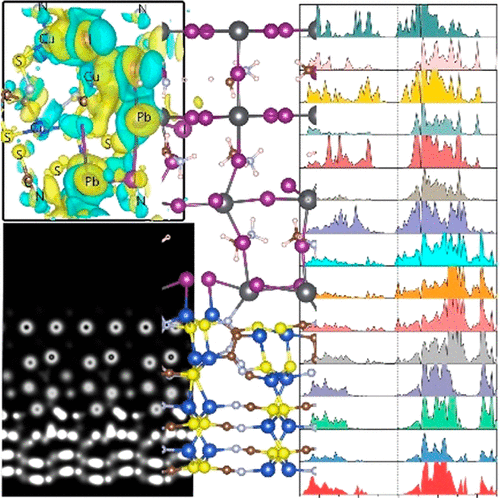当前位置:
X-MOL 学术
›
J. Phys. Chem. Lett.
›
论文详情
Our official English website, www.x-mol.net, welcomes your
feedback! (Note: you will need to create a separate account there.)
Interfacial Bonding and Electronic Structure between Copper Thiocyanate and Hybrid Organohalide Lead Perovskites for Photovoltaic Application
The Journal of Physical Chemistry Letters ( IF 4.8 ) Pub Date : 2019-09-05 00:00:00 , DOI: 10.1021/acs.jpclett.9b02101 Bingcheng Luo 1, 2 , Yuan Yao 1 , Enke Tian 1 , Kun Shen 1 , Hongzhou Song 3 , Haifeng Song 3 , Baiwen Li 3
The Journal of Physical Chemistry Letters ( IF 4.8 ) Pub Date : 2019-09-05 00:00:00 , DOI: 10.1021/acs.jpclett.9b02101 Bingcheng Luo 1, 2 , Yuan Yao 1 , Enke Tian 1 , Kun Shen 1 , Hongzhou Song 3 , Haifeng Song 3 , Baiwen Li 3
Affiliation

|
Interface engineering of halide perovskite solar-cell device layers has been showing potential for the enhancement of efficiency and stability. The replacement of spiro-OMeTAD with cheap hole extraction layer CuSCN has emerged as one effective method for the long-term large-scale application. To clarify the interfacial mechanism between the halide perovskite layer and the CuSCN layer, first-principles calculations were performed. An interface-induced electrostatic potential increase and electron–hole excitation were observed at the interfaces. A Cu–I bond and a Pb–N bond were formed at the interface. The MAI interface exhibited a larger ionic displacement and a higher interface-induced potential than the PbI interface. Strong hybridization among Cu 4d, I 5p, N 2p, and Pb 6p orbitals at the interface was found to be the origin of the electron–hole excitation, interface reconstruction, electron charge redistribution, and stability enhancement.
中文翻译:

硫氰酸铜与杂化有机卤化铅钙钛矿之间的界面键合和电子结构,用于光伏应用
卤化物钙钛矿太阳能电池器件层的界面工程已经显示出提高效率和稳定性的潜力。用廉价的空穴提取层CuSCN替代spiro-OMeTAD已经成为长期大规模应用的一种有效方法。为了阐明卤化物钙钛矿层和CuSCN层之间的界面机理,进行了第一性原理计算。在界面处观察到界面引起的静电势增加和电子空穴激发。在界面处形成了Cu–I键和Pb–N键。MAI界面显示出比PbI界面更大的离子位移和更高的界面感应电势。Cu 4d,I 5p,N 2p,
更新日期:2019-09-05
中文翻译:

硫氰酸铜与杂化有机卤化铅钙钛矿之间的界面键合和电子结构,用于光伏应用
卤化物钙钛矿太阳能电池器件层的界面工程已经显示出提高效率和稳定性的潜力。用廉价的空穴提取层CuSCN替代spiro-OMeTAD已经成为长期大规模应用的一种有效方法。为了阐明卤化物钙钛矿层和CuSCN层之间的界面机理,进行了第一性原理计算。在界面处观察到界面引起的静电势增加和电子空穴激发。在界面处形成了Cu–I键和Pb–N键。MAI界面显示出比PbI界面更大的离子位移和更高的界面感应电势。Cu 4d,I 5p,N 2p,































 京公网安备 11010802027423号
京公网安备 11010802027423号